Each film would be remade. One by a French director, one by another German director and one by an American director. This is a look at both the original film and its re-imagining.
DAS CABINET DES DR. CALIGARI ( THE CABINET OF DR CALIGARI) premiered in Berlin on February 26, 1920
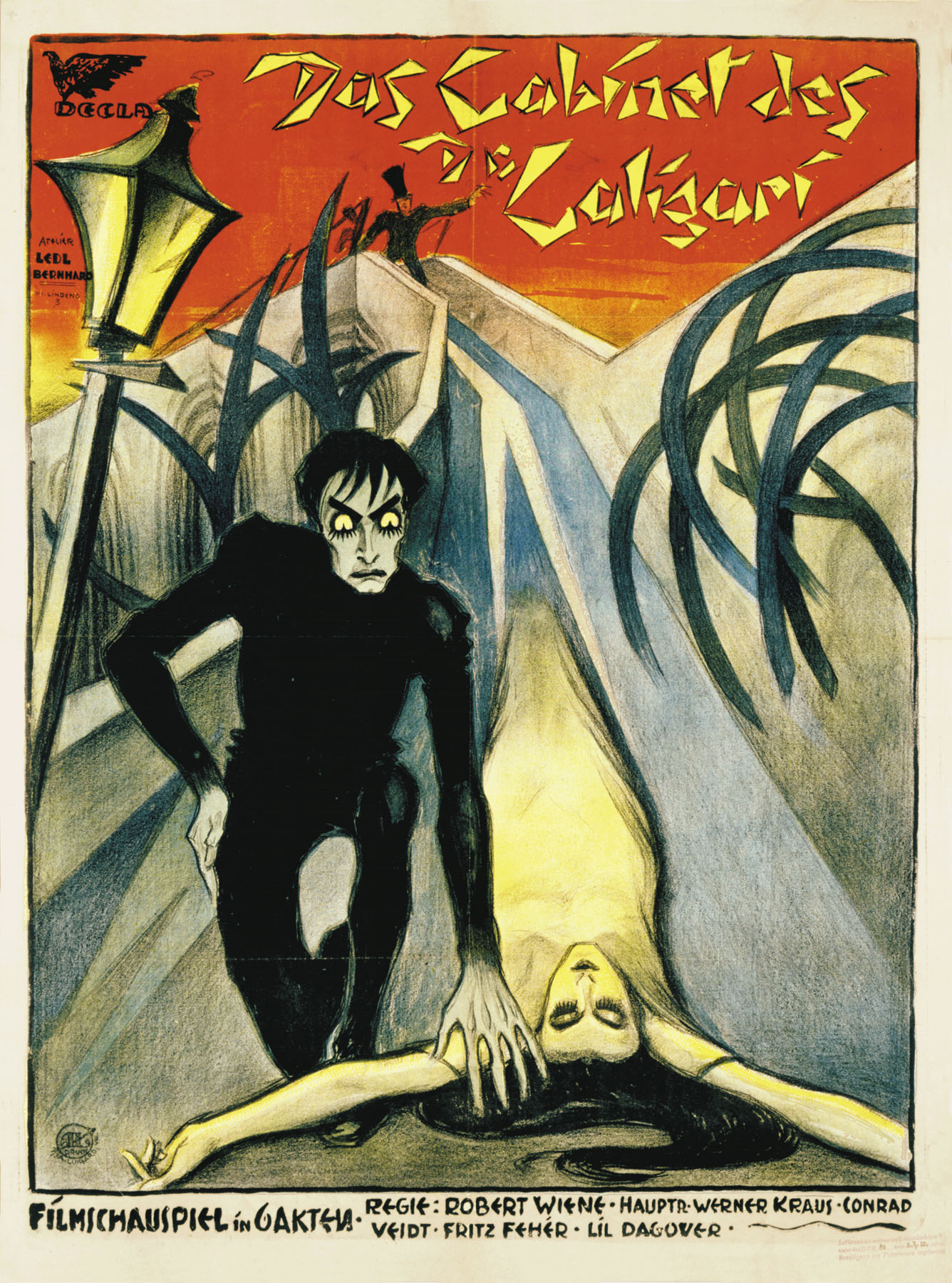
This motion picture and the one to follow are both examples of "German Expressionist Cinema". Motion pictures were one part of the "Expressionist" movement in Germany just prior too, during and after the First World War. That movement was also seen in architecture, dance, painting and sculpture.
A basic definition for German "Expressionist Cinema" during this period would be that:
It comes partly from German Romanticism and gives a subjective view of the world. It visualizes the country's collective anxiety through distorted and nightmarish imagery.A complete description may be read at:
https://www.studiobinder.com/blog/german-expressionism-film/
"The Cabinet of Caligari" was written by Carl Mayer and Hans Janowitz.
Mayer became a pacifist during the First World War. As a writer he was a perfectionist and would have minor problems with producers over the time he took him to write a screenplay. After this feature Carl Mayer became a sought after writer. Among his works were director F.W. Murnau's variation of Victor Hugo's "The Hunchback of Notre Dame", from 1921, entitled "The Hunchback and the Dancer', in 1924 he wrote Murnau's classic "The Last Laugh", in 1927 both Murnau as director and Mayer as writer made the American silent classic "Sunrise: A Song of Two Humans". That American silent starred popular actors George O'Brien and Janet Gaynor. Mayer wrote 33 screenplays during his career
Hans Janowitz only wrote 9 screenplays. "The Cabinet of Dr Caligari" was his first, but his third screenplay is also a classic example of German Expressionism. This was also 1920's "The Head of Janus". The film starred Conrad Veidt as "Dr, Warren" and "Mr. O'Connor". The film was really Robert Lewis Stevenson's "Dr. Jekyll and Mr. Hyde".
"The Cabinet of Dr. Caligari" was directed by Robert Wiene. Wiene started directing in 1913 and would have 66 motion pictures to his film credit. Among his Internationally known works, besides this picture, are the 1923 version of Fyodor Dostoevsky's "Crime and Punishment" and the first film version of French author Maurice Renard's psychological horror story, 1924's, "The Hands Orlac". Which again featured Conrad Veidt. When the Nazi's came to power Wiene, like many Jews, left Germany, first for England and after the war France.
Suffering from cancer Wiene could not finish his last film a 1938 spy story, His best friend Robert Siodmak did. Robert and his brother Kurt (Curt) also fled Nazi Germany, because they were Jewish. Robert became the most prolific of American Film Noir directors and Curt wrote, among other Horror films, Universal Picture's 1940 "The Wolfman" and both brothers worked together on Universal's 1943 "Son of Dracula". Their story can be found at:
http://www.bewaretheblog.com/2017/11/curt-and-robert-siodmak-horror-and-film.html
Before I move to the performers I must mention the non screen credited set designer Hermann Warm. The sets are critical to this feature film's look and normally, when spoken of, Warm is forgotten. His work included the 1922 mystery "Phantom", from a screenplay by Fritz Lang's wife Thea Von Harbou, director Carl Theodor Dreyer's 1928 "The Passion of Joan of Arc" and Dreyer's 1932 classic "Vampyr".
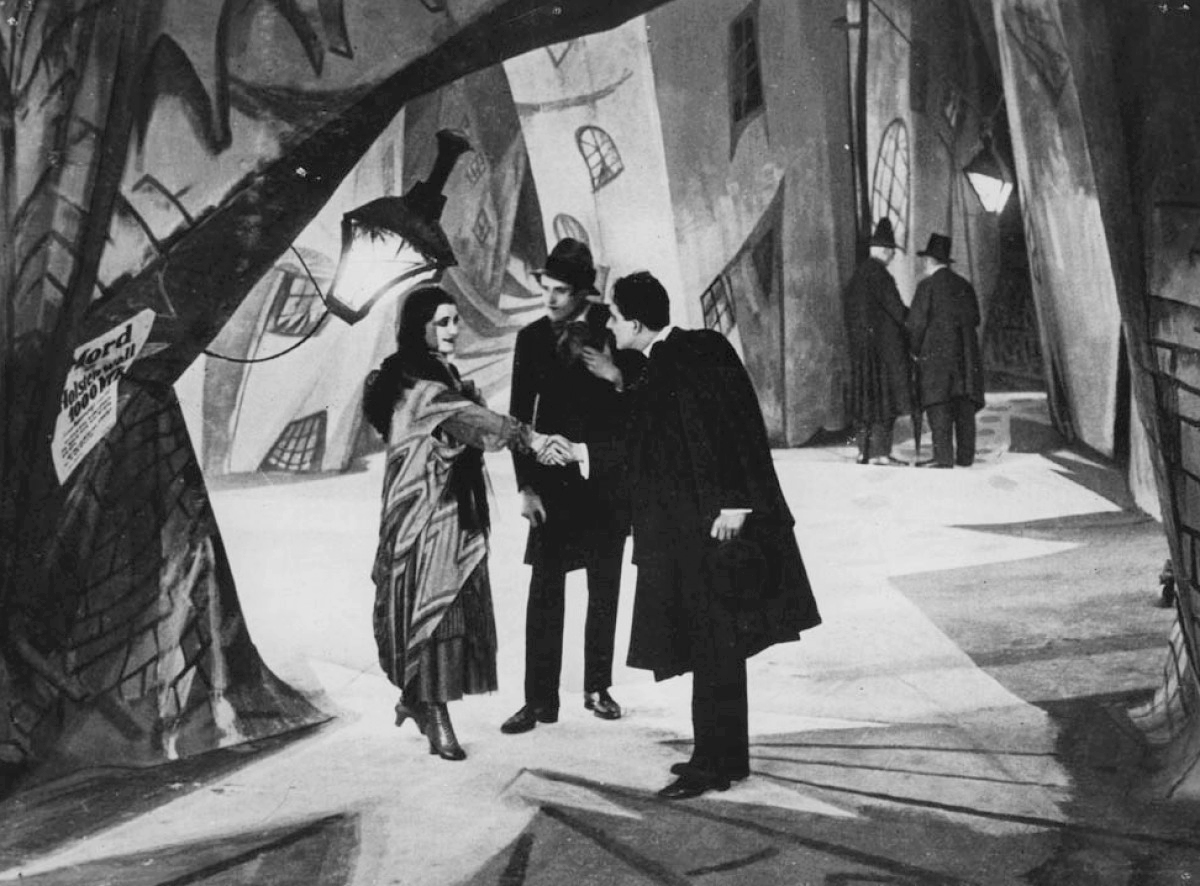
The Six Leading Actors
Werner Krauss was "Dr Calagari". Krauss had started his acting career in 1914 and at its end would have 146 on screen credits in 1958. One of his more interesting roles was in 1921 as "Lord William Hamilton". He was opposite Conrad Veidt as "Lord Nelson" in the German version of the story of "Lady Hamilton" and her affair with Admiral Nelson. Another historical role was portraying "Napoleon" in the 1929 German film "Napoleon at St. Helena".

Conrad Veidt was "Cesare the Somnambulist". Veidt, besides the motion picture roles referred too above and this film. Would be seen in 1928 as Victor Hugo's "The Man Who Laughs", He wears a truly horrific make-up. Later, Veidt ate up the screen, as the evil "Jaffar" in the Korda Brother's 1940 "The Thief of Bagdad". That role and look was the inspiration for "Jafar" in Disney's 1992 animated "Aladdin". In 1942 he was a Nazi Officer in the classic love story "Casablanca".
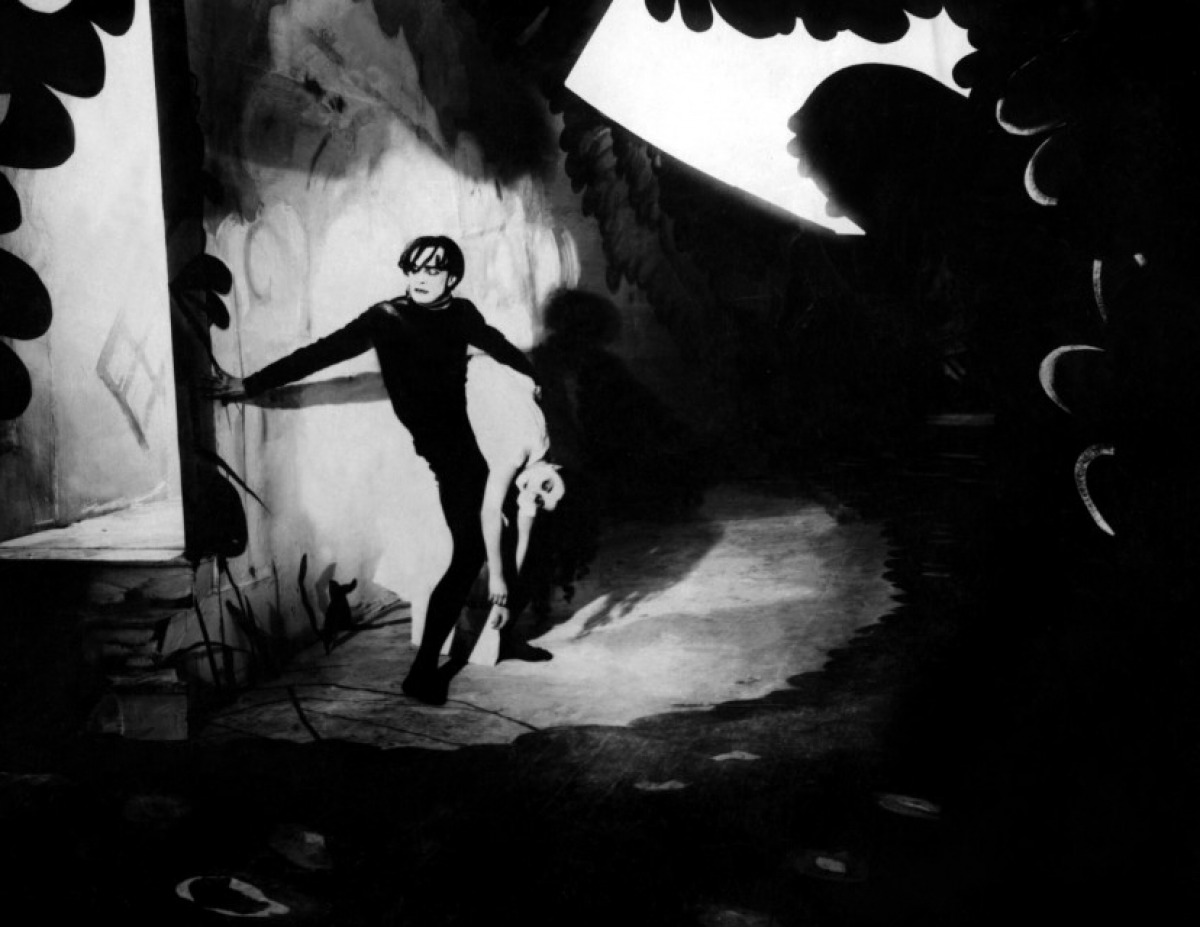
Friedrich Feher was "Franzis". Feher was both a director and actor and in each category had 32 credits. This was his 18th acting role. In 1936 he also left Germany for the United States were he directed one motion picture and appeared in another.

Lil Dagover was "Jane Olsen". Unlike some of the above who left Nazi Germany. Dagover continued in the German cinema during World War 2. She was a favorite actress of Nazi Germany.
In 1974 Lil Dagover portrayed "Bertha von Suttner" in director and producer Hans-Jurgen Syberg's "Karl May". A three hour alleged biography of the German writer of many American Westerns Karl May. This was the second film in Syberg's "German Trilogy". Which gives the viewer a "mythical foundation" for the creation of "The Third Reich". How May, who died on March 30, 1912, could be part of the foundation for the rise of the Nazi's is an interesting theory. However, if you like Western movies and might also be interested in Karl May. My article, "American Western's European Style", that even speaks to a Soviet Union "B" Cowboy movie, can be read at:
http://www.bewaretheblog.com/2015/01/american-westerns-european-style.html

Hans Heinrich von Twardowski was "Alan". Twardowski also left Nazi Germany for the United States. An ardent anti-Nazi he was usually cast as a Nazi in American and U.K. films.

Rudolf Lettinger was "Dr. Olsen". Lettinger started acting in 1912 and his last role was in 1931. He passed away six years laters.

An Overview of the Original Screenplay.
The character of "Dr. Caligari" had an actual foundation with German philosopher Arthur Schopenhaurer.
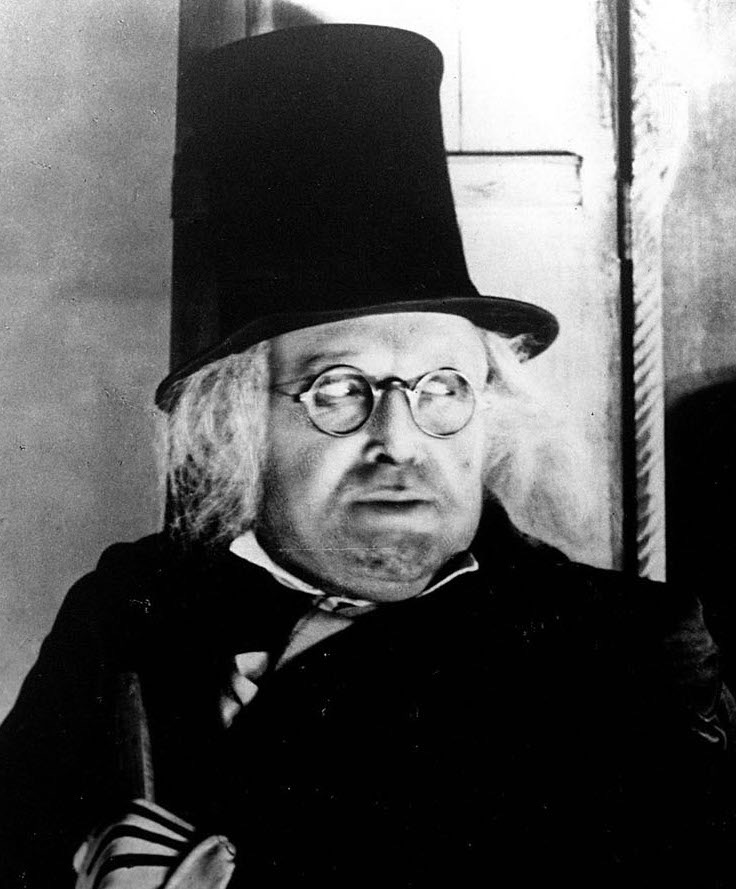
Above Werner Krauss and below Arthur Schopenhauer.

During his lifetime, February 28, 1788 to September 21, 1860, Schopenhauer's work on aesthetics, morality, and psychology were considered too radical and was criticized by others in those fields. However, as often happens, his work was discovered and quoted by many famous people as fact. These included Friedrich Nietzsche, Richard Wagner, Leo Tolstoy, Albert Einstein, George Barnard Shaw, Sigmund Freud and Samuel Beckett.
The following quote by Schopenhauer from his "On the Fourfold Root of the Principle of Sufficient Reason" goes directly to the "Caligari" screenplay:
The sensations in the hand of a man born blind, on feeling an object of cubic shape, are quite uniform and the same on all sides and in every direction: the edges, it is true, press upon a smaller portion of his hand, still nothing at all like a cube is contained in these sensations. His Understanding, however, draws the immediate and intuitive conclusion from the resistance felt, that this resistance must have a cause, which then presents itself through that conclusion as a hard body; and through the movements of his arms in feeling the object, while the hand's sensation remains unaltered, he constructs the cubic shape in Space. If the representation of a cause and of Space, together with their laws, had not already existed within him, the image of a cube could never have proceeded from those successive sensations in his hand.As the story is one of perception and what one thinks is happening versus reality.
The film opens with "Franzis" sitting on a bench next to an older man, The older man is complaining that the spirits have driven him from his home and family, As he talks a women in a trance like state walks past the two. "Franzis" begins his story by telling the old man that the women was "Jane" his fiancee. Adding that they have suffered a great ordeal.
.png)
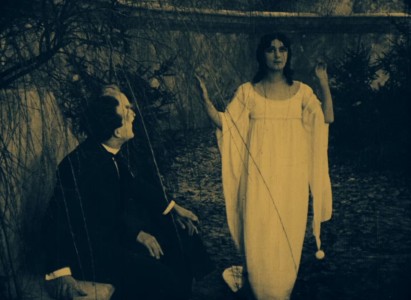
FLASHBACK
This is were Herman Warm's sets kick in. As "Franzis" states, with "Jane", they both lived in the village of "Holstenwall". The village is all twisted shaped houses and streets.

"Franzis" and his good friend "Alan", both competing for "Jane's" love, plan to visit the town fair. While at the clerk's office "Dr. Caligari" asks the city clerk for a permit to show an exhibit at the fair. When asked what it is the doctor wishes to exhibit? The clerk laughs at the answer of a somnambulist named "Cesare". The following night the clerk is found stabbed to death in his bed.
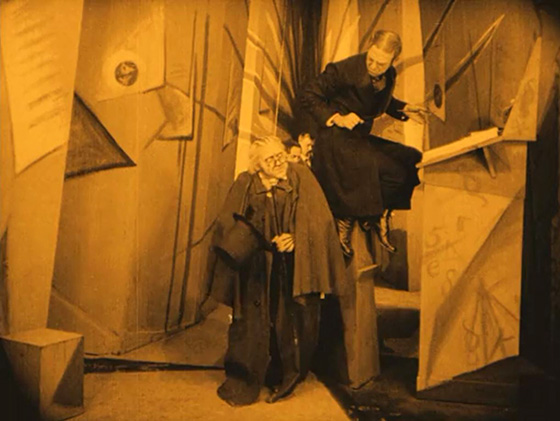
The fair opens and "Franzis" and "Alan" visit it and enter "Caligari's" exhibit. Finding the sleeping "Cesare" is in a box, or the cabinet of the film's title.

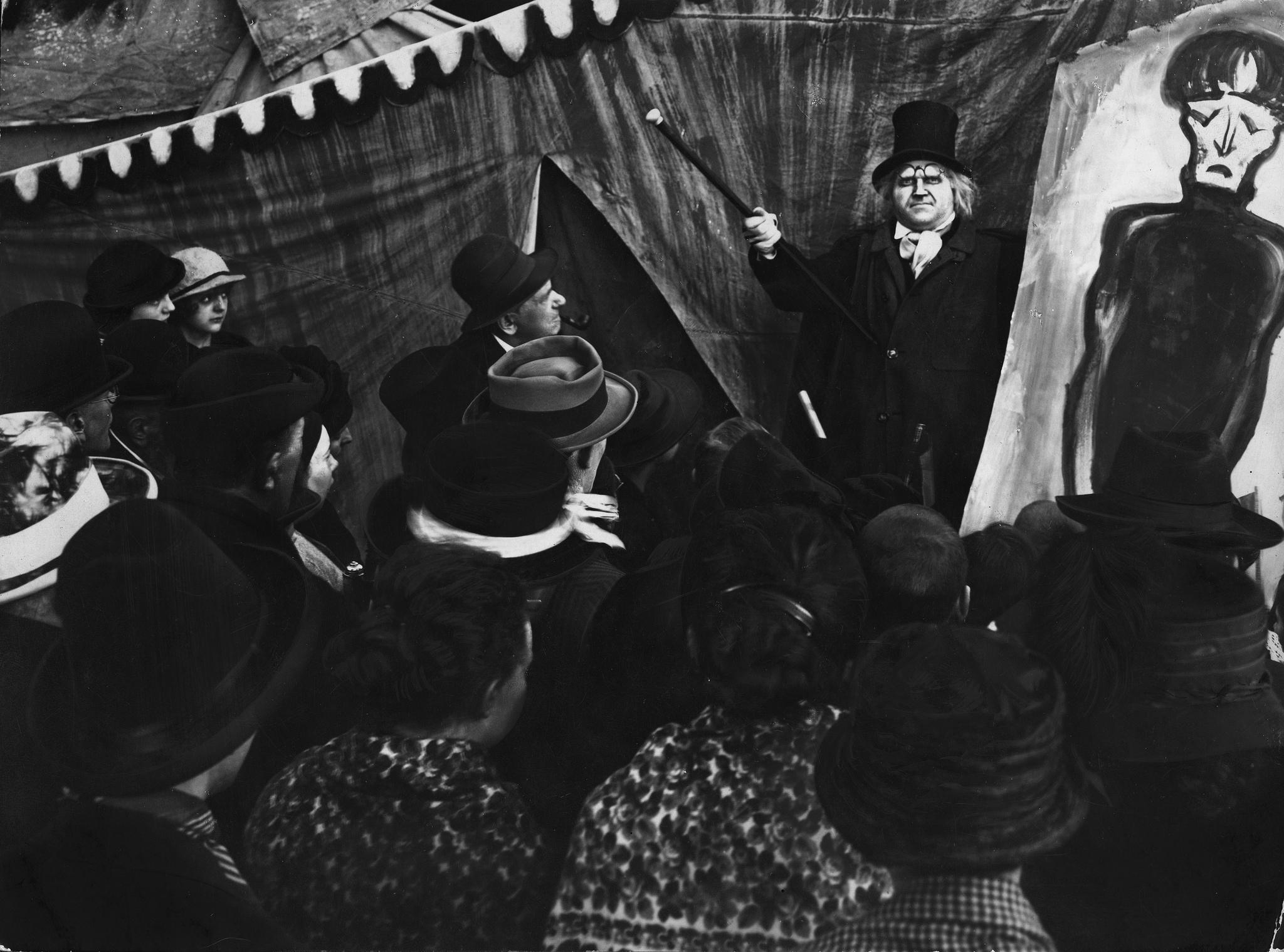
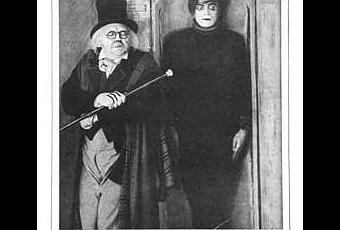
The doctor awakes the sleeping "Cesare". Once awake, "Caligari" tells his audience that the somnambulist will answer their questions and can foretell the future. "Alan" asks how long he will live and receives the reply:
UNTIL DAWN!Later that night a figure breaks into "Alan's" house and stabs him to death.
"Franzis" decides to investigate the death of his friend with the help of "Jane" and her father "Dr. Olsen". They get a police permit to search "Dr Calagari's" exhibit. That night the police arrest another man who was about to kill an old women.
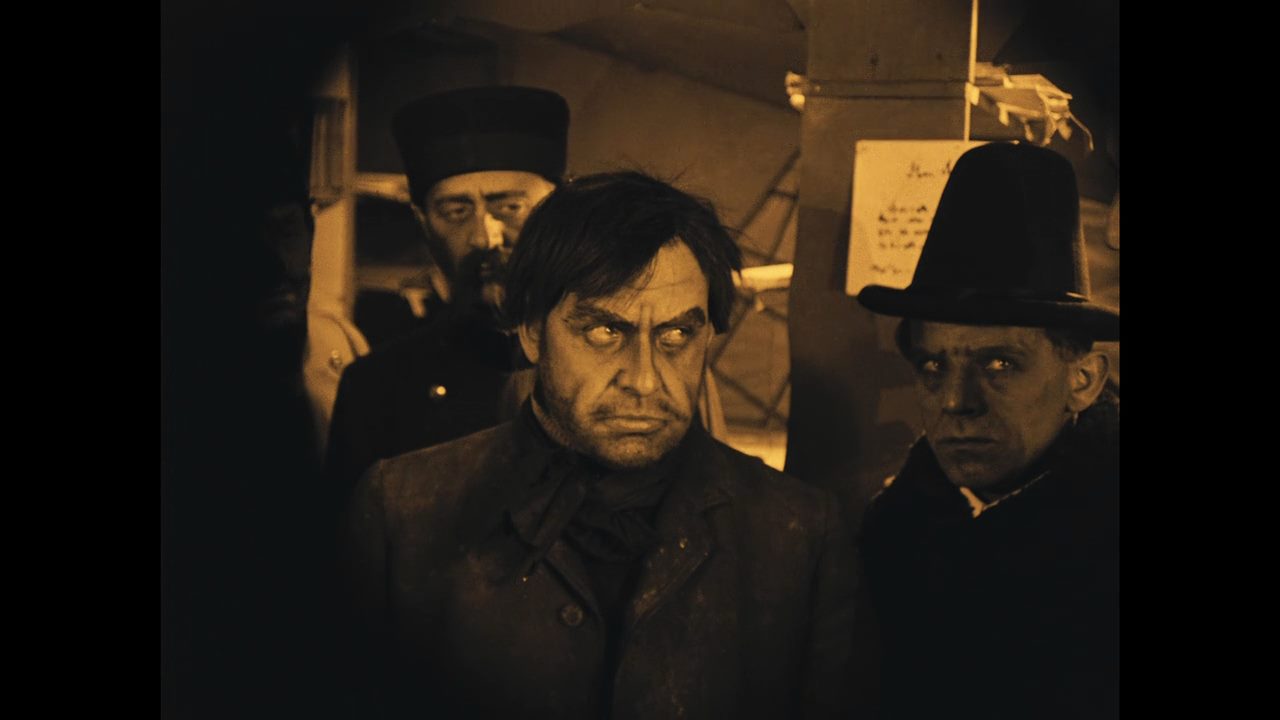
He admits to wanting to kill the old women, but claims he has no connection to the other murders. The criminal admits he was using the other murders in an attempt to cover his own.
The next night "Franzis" spies upon "Dr. Caligari" and observes what appears to be "Cesare" sleeping in his box. However, this is a dummy and the real "Cesare' now enters "Jane's" house. He rises a knife to kill the sleeping girl.



Strangely, instead of killing "Jane" as "Dr Caligari" has commanded him. He decides to kidnap her and there is a struggle knocking "Jane" unconscious. Picking up the girl "Cesare" drags her through a window, across the roof tops, and down into the streets below.
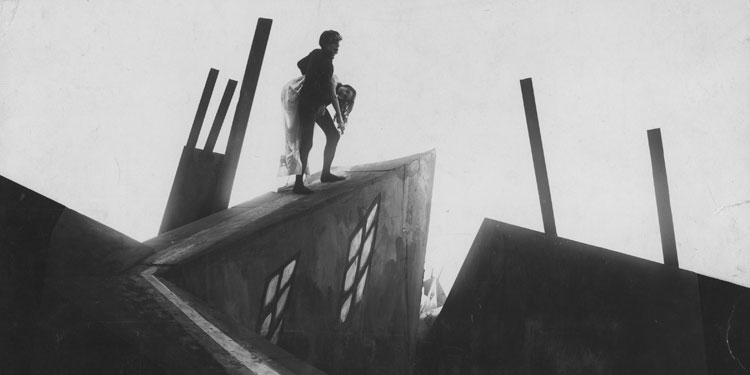

A mob of towns people, angry over the murders, is formed and spots "Cesare" carrying "Jane". The mob starts to pursue him. He suddenly drops "Jane" in the street, collapses and dies.
"Francis" is able to confirm to the police that their captured criminal is not be the murderer. Accompanied by the police, he goes to investigate "Dr Calagri's" exhibit and they discover the dummy "Cesare" in the box.
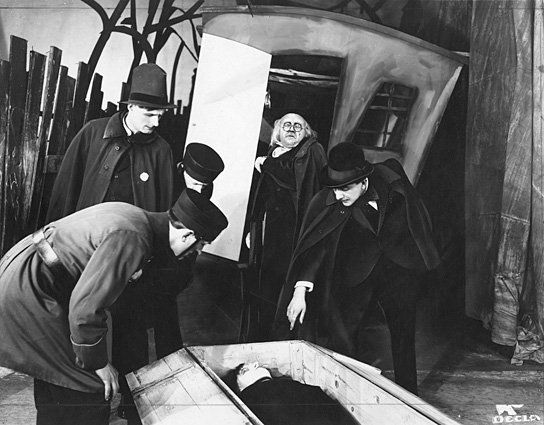
In the confusion caused by this investigation the doctor escapes. However, "Franzis" sees him leave and follows the "Caligari" through the entrance to a insane asylum.
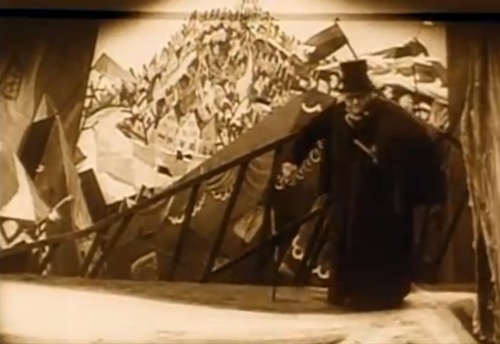
"Franzis" is shocked to learn that the exhibitor, "Dr Caligari", is actually the asylum's director. He gets help from some of the staff and while "Caligari" is asleep goes through his records. "Franzis" discovers that the director is obsessed with an Italian mystic named "Caligari". Who used a somnambulist, also named "Cesare", to murder. The director, believing he is the other "Caligari", operated on a somnambulist admitted to his insane asylum and renamed him "Cesare".
The director appears and confronted by "Franzis" and his staff screaming:
I AM CALIGARI!The director's staff call the police to report what has been discovered. The police arrive and are first shown "Cesare's" corpse, but "Caligari" attacks his staff and is restrained. He is placed in a strait-jacket and becomes an inmate of his own insane asylum.
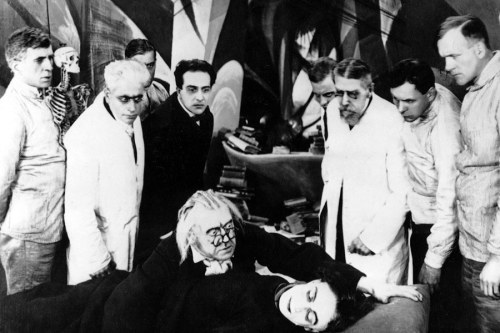
However, this is not the ending to "The Cabinet of Dr. Caligari".
The story returns to "Franzis" and the old man sitting on the bench. The man "Franzis" has called "Caligari" is the real insane asylum director. However, "Jane" is actually an inmate who believes she is a Queen. "Cesare" is a silent inmate, not a somnambulist, is always awake, and not dangerous at all. While "Franzis" is also an inmate and now understanding his delusions feels the real director can finally cure him.

Sometimes, as in the above screenplay, you are deluded into believing what you are seeing is something else. As it was with the motion picture I saw when I was 15.
There had been a television program in 1960 entitled "Silents Please". In the half hour program, commercial time included, full length silent films were cut down to give the viewer the story line. Some films were divided into two parts. It was here that I first met Lon Chaney as "The Hunchback of Notre Dame", John Barrymore as "Dr. Jekyll and Mr. Hyde", and Conrad Veidt in "The Cabinet of Dr. Caligari".
I had also read about that film in 4E's "Famous Monsters of Filmland" and, therefore,was primed for:
THE CABINET OF CALIGARI released May 25, 1962

I must also admit that the box on the lower right of the above poster intrigued me.
NO ONE Permitted OUT OR IN During The Last 13 Nerve-Shattering Minutes!With his first thriller 1958's "Macabre". William Castle's gimmick of insuring his audience, with the prestigious "Lloyd's of London", should a viewer be scared to death during the film. Had started the "Gimmick Movie" craze. This motion picture was just another example.
The Story Of How This Movie Was Made
The film would be produced and directed by Roger Kay. Who was a French live stage producer with a specialty of "Grand Guignol (Naturalistic Horror)" productions. Kay also had degrees in psychology.
Back in 1921 Studio Head Samuel Goldwyn purchased the rights to the original 1920 German film and then sat on them. This was the same year that Roger Kay was born in Cario, Egypt. Goldwyn would produced his own last motion picture, George Gershwin's "Porgy and Bess", in 1959, but sometime either in 1959, or shortly before. It appears he turned over, or sold, the film rights to "The Cabinet of Dr. Caligari" to Frenchman Roger Kay.
Between 1956 and "Cabinet of Caligari". Kay had only directed 19 assorted television programs, but no feature films. This was his first motion picture and he would only have four more directing credits through his career ending in 1981. As a film producer Kay would have only one more film shot in France.
No on screen credit goes to "Executive Producer" Robert L. Lippert. Among his films are, from director Sam Fuller, 1949's "I Shot Jesse James", 1950's "The Baron of Arizona" starring Vincent Price, and the 1951 Korean War drama "The Steel Helmet" starring Gene Evans. Lippert's Science Fiction and Horror films include 1950's "Rocketship X-M", 1951's "Lost Continent", Hammer's 1955 "The Quartermass X-periment" and, in 1958, the original "The Fly" also starring Price.
The story was written by Robert Bloch. Who two years earlier had written Alfred Hitchcock's "Psycho" and two years afterward would write screenplays for William Castle's 1964 "Strait-Jacket" and "The Night Walker".
According to Robert Bloch in his autobiography "Once Around the Bloch" written in 1993. Roger Kay gave him instructions:
to drop the Dr from the original title but do a story with enough similarity to be recognizable as an homageMy reader needs to read Robert Bloch's autobiography for the battle over Rodger Kay wanting to remove Bloch's name from the film and put his own in as the writer.
Additionally, 20th Century Fox, as it always seemed to do, got involved with the screenplay and final cut. What I saw on screen, apparently, was not as written by Bloch, or even imagined by Kay.
The Cast
Glynis Johns portrays "Jane Lindstrom". I first saw South African born actress Johns in the 1951 British film "No Highway in the Sky" co-starring with James Stewart and Marlene Dietrich. Walt Disney cast her first as "Prince Mary Tutor" in 1953's "The Sword and the Rose" and than as "Helen Mary MacPherson MacGregor" in 1953's "Rob Roy: the Highland Rogue". Glynis Johns is probably best known as "Mrs. Banks" in Walt Disney's 1964 "Mary Poppins". Her comedy talents were showcased in the Danny Kaye rip-off of Errol Flynn's 1939 "Robin Hood". That motion picture was 1955's "The Court Jester", but in this film her dramatic talent was center stage.
The first two Disney films I mentioned above are part of a group of four made in the U.K. The other two are 1950's "Treasure Island" and 1951's "Robin Hood". My article on all four films and why they had to be made in the U.K. can be found at:
http://www.bewaretheblog.com/2016/09/walt-disneys-british-tax-motion.html
.jpg)
Dan O'Herlihy was both "Paul" and "Caligari". The Irish actor had been seen on screen since 1947 and among his works prior to this motion picture. Are the very good, low budget, "Cold War" thriller from 1952 "Invasion U.S.A.", the still excellent 1954 "Robinson Crusoe" , and 1961's "King of the Roaring 20's: The Arnold Rothstein Story". However, the actor is best known to Science Fiction fans as "Grig" in 1984's "The Last Starfighter" and for his role in both 1987's "RoboCop" and 1990's "RoboCop 2". O'Herlihy was also the Warlock in 1982's "Halloween III: the Season of the Witch".
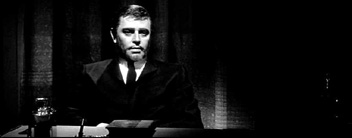
Richard "Dick" Davalos was "Mark". Davalos had been basically a television actor since 1953. However, he had roles in the James Dean 1955 "East of Eden", John Wayne's 1955 "The Sea Chase" and the Jack Palance 1955 "I Died a Thousand Times". This was his only motion picture between 1956 and 1962.
The Screenplay As I Saw The Film
What Robert Bloch came up with is actually very good and so is this forgotten motion picture with an excellent cast of actors.
The movie opens with "Jane" driving along a lonely country road when her car gets a flat tire.
.jpg)
She notices a house off the road and walks there for assistance. She is greeted by a very nice gentleman named "Caligari" who has a distinctive Welsh accent. The bearded "Caligari", because of the lateness of the hour, suggests "Jane" join his other guests for dinner and spend the night at his house and in the morning he can arrange to have the flat fixed.
The house seems very bizarre to "Jane", but that might just be because she is tired from the drive.
.jpg)
Above are three of "Caligari's" guests and for film buffs familiar faces. The first, on the left, is J. Pat O'Malley as "Martin", next is Estelle Winwood as "Ruth" and the third Constance Ford as "Christine".
The next morning "Jane" wakes up and realizes she was drugged. The young women is asked questions by "Caligari" that "Jane" considers are too personal to come from a stranger. Next she is made to look at very offensive photos. The realization that for some unknown reason she is now a prisoner of "Caligari" and so are the other "Guests" "Jane" met at dinner.
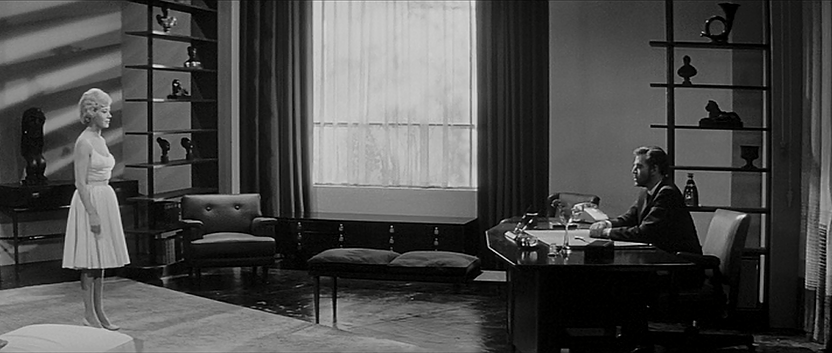
At "Jane's" first chance the frightened young women makes an unsuccessful attempt to escape the house, but is stopped by guards who suddenly appear.
'Jane" has met a staff doctor named "Paul". Who bares a resemblance to "Caligari", has an American accent, and is kind and understanding, She relates her belief that someone is spying on her even in the bath, but when this happens. "Jane" seems to be in a trance and wonders if it's all just a dream?
.jpg)

"Jane" now starts to look for allies against "Caligari" to help her escape, Especially after she sees "Ruth" being tortured by "Calgari;s" staff, but who can she trust? She immediately considers "Mark" and perhaps "Paul"?
However, she decides to attempt to first seduce "Caligari" to let her go. The seduction doesn't work, but we're now into those 'LAST 13 MINUTES".
"Caligari" reveals that he and "Paul" are the same person. He starts to add to this, but "Jane" in panic starts to run out of "Caligari/Paul's" office, but the door has become the following image.
.jpg)
As "Jane" runs down the corridor the imagery reminds the audience of the 1920 silent original,
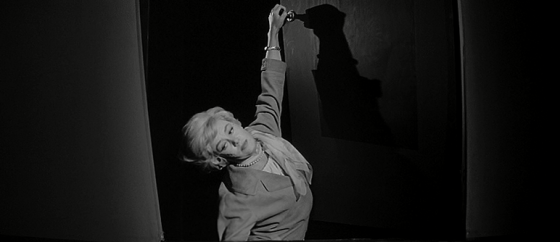

When the imagery stops. "Jane Lindstrom"finds herself still sitting in her original office chair, but clearly, now, in front of "Paul" and not "Caligari". The audience now learns that what they thought they were seeing isn't what was actually happening.
.jpg)
"Jane" has been a patient in a mental hospital and everything the audience has seen are the distortions of her mind to the reality of what was happening to her:
The question asked were all part of her psychoanalysis.
The obscene pictures were in reality a Rorschach test and "Paul" holds up on for "Jane" to respond too.
"Ruth's" torture was actually the patient getting shock therapy.A practice at the time in mental institutions to supposedly help patients be cured of mental illness.
"Jane" has been cured of her mental illness and is free to leave the hospital with her son "Mark".
One last twist as the audience sees "Jane" as she really looks like. "Jane" isn't the young woman of her mind's fantasies, but a middle aged woman with an adult son.
.jpg)
Mention vampire movies to a group of fans and if Tod Browning's 1931 "Dracula" starring Bela Lugosi doesn't come up. Then you're not with a true vampire cult. However, that film was not the first entry as many still believe and I move to:
NOSFERATU, EINE SYMPHONIE DES GRUENS (NOSFERATU: A SYMPHONY OF HORROR) premiered on February 22, 1922 at the Hague in the Netherlands

Bram Stoker published "Dracula" in 1897. The heirs of Bram Stoker sued over this unauthorized version of the novel and won in court. All copies of the motion picture were ordered destroyed, but as luck would have it. Some did survive and this classic vampire tale remains today. Another point is that this was the only motion picture made by the German company "Pranda Film" and after completion to avoid paying royalties to Mrs. Stoker. The company declared "Bankruptcy".
The screenplay was written by Henrik Galeen. Galeen would write only 23 films between 1915 and 1935. His first was a silent classic based upon Jewish legend "Der Golem (The Golem)" and starred Paul Wegener. In 1920 the two would film "Der Golem, wie er die welt kam (The Golem, How He Got Into the World)'". Galeen followed that film with this one. In 1924 Henrik Galeen wrote "Das Wachfigurenkabinett (The Wax Museum)" the first motion picture to feature "Jack the Ripper".
Should my reader be a fan of "Jack". My article covering all the movie and television appearances through 2015 can be read at:
http://www.bewaretheblog.com/2015/09/jack-ripper-in-motion-picture-and.html
The motion picture was directed by F.W. Murnau (Friedrich Wilhelm Murnau). Murnau would direct 21 motion pictures, I already mentioned the director in connection with Carl Mayer the co-screenplay writer of 1920's "The Cabinet of Dr. Caligari" and the other co-writer Hans Janowitz. Starting in 1926 F.W. Murnau made four films in the United States. The last "Taboo: A Story of the South Seas" was released, in August 1931, five months after his death at age 42.
The Main Cast
Max Schreck, in German his last name is a version of "Schrecken", which means Horror or Fright in English, was "Count Orlok" the "Dracula" character. This was the actor's 5th role. Between 1920 and 1936 Schreck appeared in 46 roles.
As to the legend that Schreck might have been a real vampire and the excellent movie from 2000 "Shadow of the Vampire". Which played off of that and featured Willem Dafoe as Schreck and John Malkovitch as Murnau. The real Schreck looked like this, in 1922 on the left, minus his fangs. However, those are real ears.
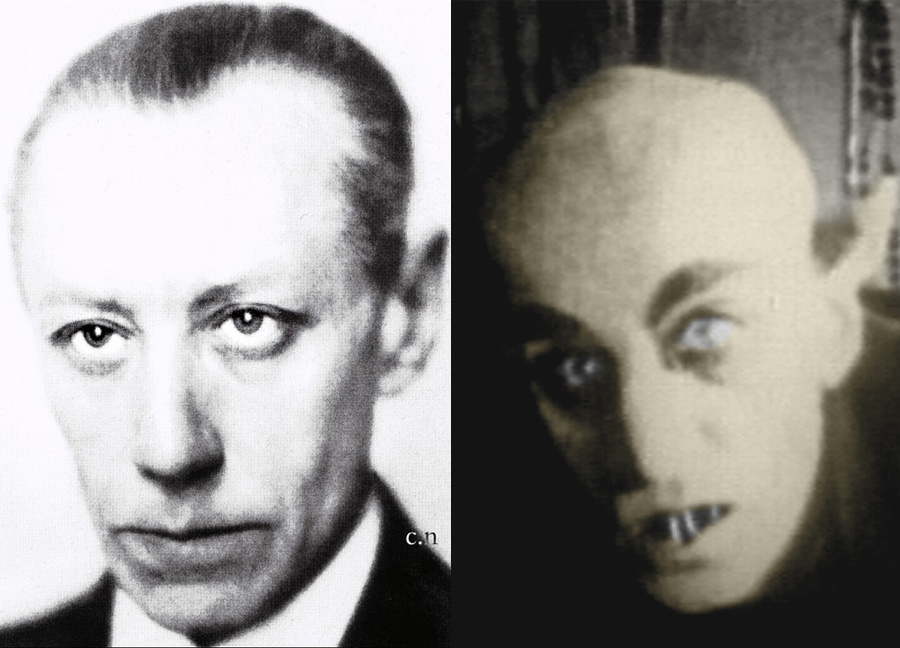
Gustav von Wangenheim portrayed "Thomas Hutter" the "Jonathan Harker" character. This was von Wangenheim's 14th motion picture out of 20. In actuality the actor was a German nobleman born Ingo Clemens Gustav Adolf Freiherr von Wangenheim. This was not the only classic German Horror,or Science Fiction film he was in. He was in both 1916'a "Homunculus 1: Teil" and the same years "Homunculus 2: Teil". Which are part of what is considered the German artificial human series of Science Fiction movies with 1918's "Alune" and 1926's "Metropolis".

Greta Schroder is "Ellen Hutter" the "Mina Harker" character. In the motion picture "Shadow of the Vampire" "Schroder was portrayed as a "Famous Actress". She was not and her film career over 41 years only totaled 18 roles. This film was her 7th motion picture. In 1920 Greta Schroder had 10th billing in the second version of "The Golem" I have previously mentioned. For those of my readers in the entire story of "The Golem" on film through the British production starring Roddy McDowell. You can read my article at "THE GOLEM: The Wrath of God" at:
http://www.bewaretheblog.com/2018/02/golem-wrath-of-god-in-motion-pictures.html
John Gottowt was "Professor Bulwer" the "Van Helsing" character, but by his costume is also Jewish. Gottowt appeared in 28 film roles. Among his films was director Robert Weine's forgotten 1920 "Genuine: The Tragedy of a Vampire". The same year he was in F,W, Muranu's "The Hunchback and the Dancer" and in 1924 he was also in "The Wax Museum".

Alexander Granch was "Knock" the "Renfield" character. Character actor Granch had a very interesting career starting in German films in 1919. As others I have mentioned, he was Jewish, and left Germany as the Nazi's came to power. Among his other films was the classic directer Ernst Lubitsch's 1939 comedy "Ninotchka" starring Greta Garbo and 1943's For Whom the Bell Tolls" starring Gary Cooper and Ingrid Bergman.
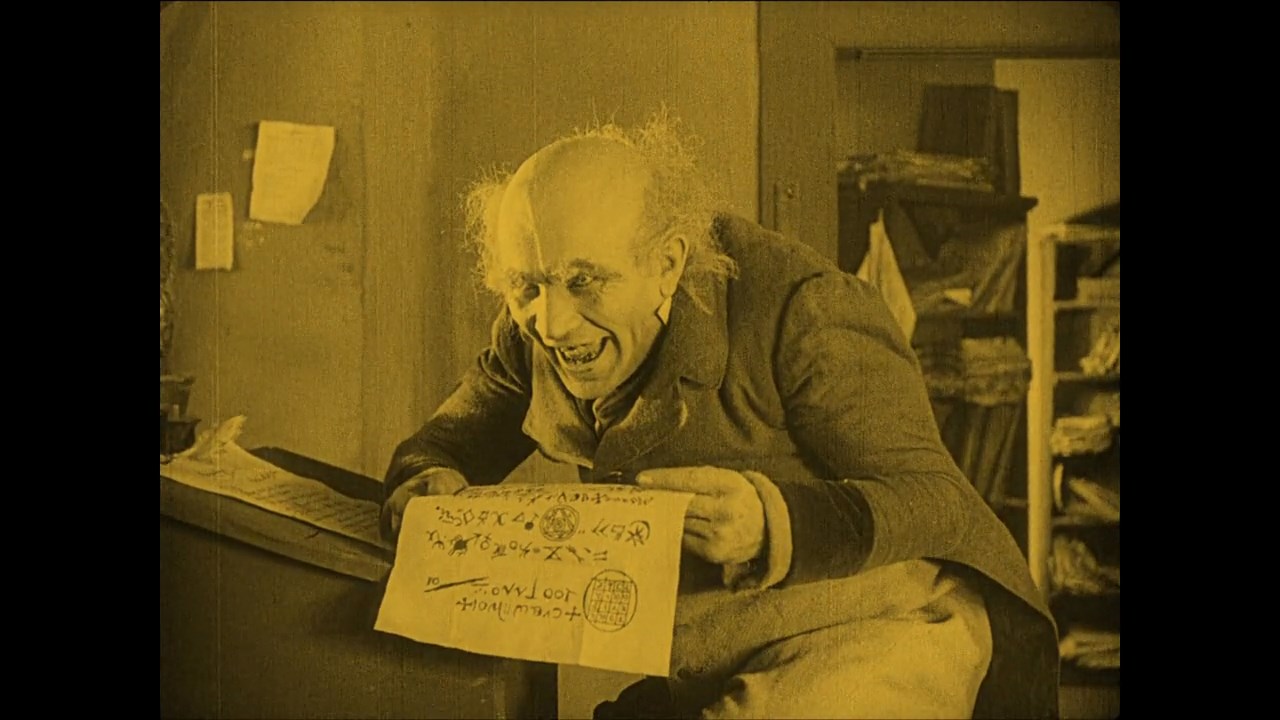
An Overview of Henrik Galeen's Screenplay
An obvious change to the Bram Stoker novel are the names of the characters. The setting is 1838 in the fictional German town of Wiesborg. In the novel the story is set in the 1890's and most of the action takes place in England.
"Thomas Hutter" works for the area's real estate agent "Knock". "Thomas" and his wife "Ellen" are just making ends meet. When "Knock" tells him of a nobleman wanting to purchase a home in Wiesborg and the large commission he can make off the purchase. "Hutter" is delighted, but there is a condition.

He must go to the buyers castle in Transylvania and deal with him in person. "Thomas" tells "Ellen" of this chance, and, although, she has some worries, she agrees to his journey.
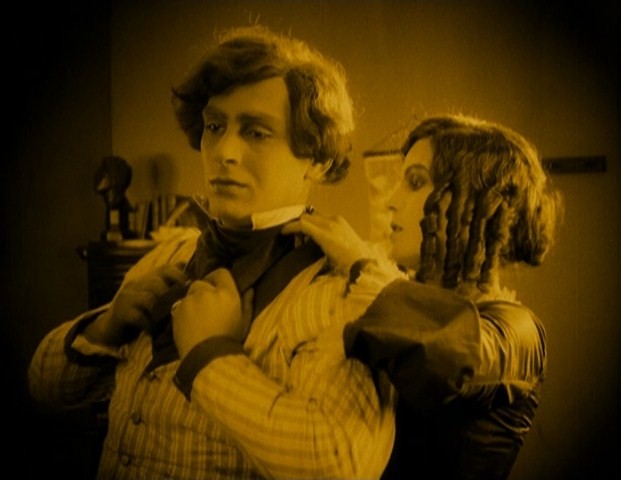
"Thomas" leaves "Ellen" in the care of their friends Ship owner "Harding, played by Georg H. Schnell, the "Arthur Holmwood" character, and his wife "Annie" played by Ruth Landshoiff, the "Lucy Westenra" character. Both characters are not part of the major plot.
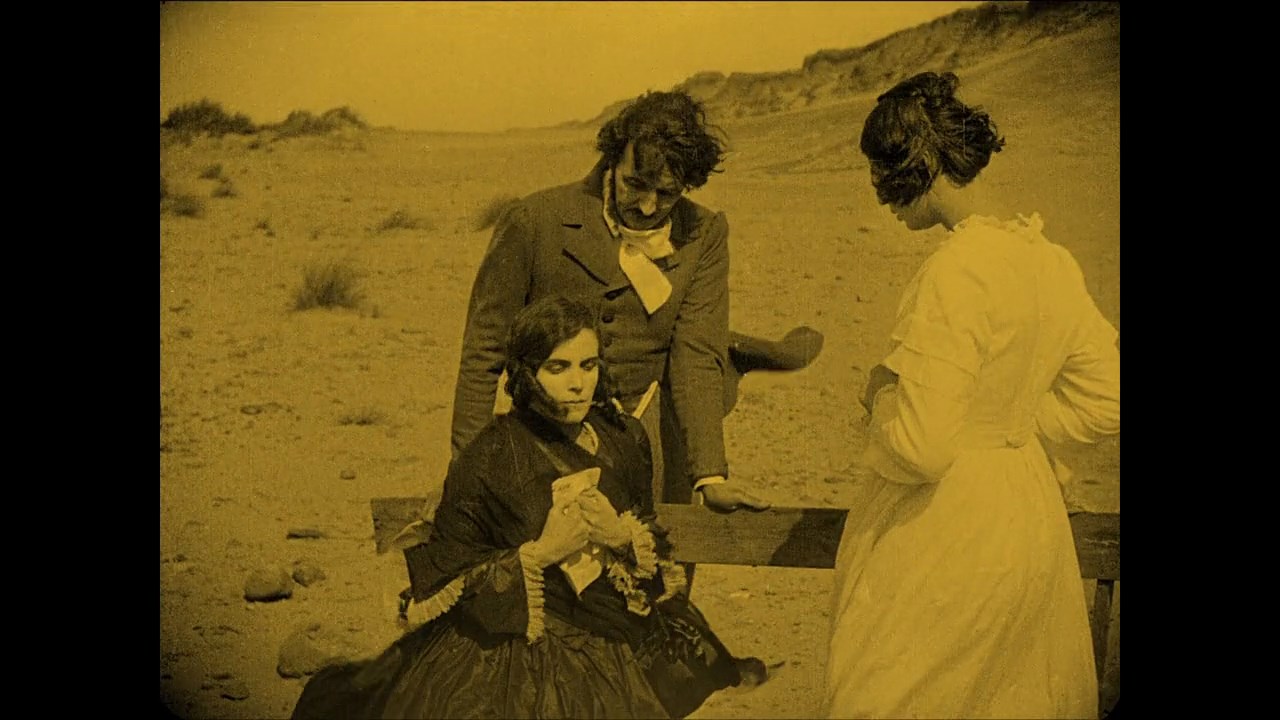
"Hutter" is in Transylvania and nearing his destination decides to stop at a local Inn. The owner and patrons suddenly become frightened at the mention of the name "Count Orlok". They warn him to turn back and they speak of werewolves and vampires, but "Thomas" laughs them off and starts out in a rented carriage of his own. Out of seemingly nowhere a wolf spooks his horses and he is forced to go back and spend the night at the Inn. There he finds a book with the title:
THE BOOK OF VAMPIRESWhich he decides to read, In it is a passage warning him that it is not always possible to recognize dangerous beasts when they appear. Again he laughs it off. but keeps the book.

The next day "Thomas" leaves in a coach and as night is falling the driver stops at a bridge and refuses to go further. "Hutter" is left alone and starts to walk across the bridge. Looking across the bridge he views a coach heading his way at a fantastic rate of speed. It stops on the opposite side of the bridge and "Thomas Hutter" now finishes crossing it to meet the coachman. Who is to take him to "Count Orlok's" castle.




The coach arrives at the castle and "Thomas Hunter"is greeted by "Count Orlok". Although, as the audience knows, it was the Count driving the coach.

While eating his dinner "Hutter" cuts himself with a knife and "Orlok" attempts to suck his blood, but "Thomas" pulls his hand away. After being shown the paperwork to sign and reading it. The Count takes "Thomas" to his room and observes a photo of "Ellen Hutter". It is the two word comment made by "Count Orlok" that is telling:
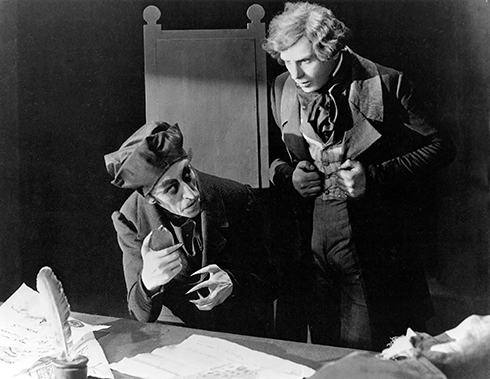
LOVELY NECKBack at home "Ellen Hutter" starts sleep walking and seems to be under a spell of the Count. Even though she is in Wiesborg and the Count is still at his castle. She awakes from a nightmare that her husband is in some form of battle with "Count Orlok".

At one point "Harding" and "Annie" call "Dr. Sievers", played by Gustav Botz, to examine "Ellen" over her recurring nightmares.
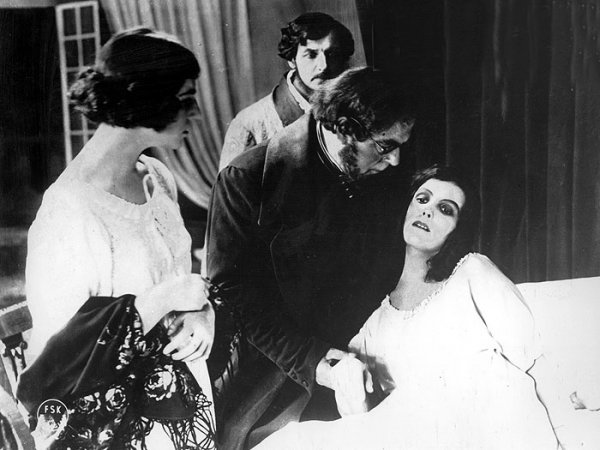
At the castle "Thomas Hutter" discovers the coffin of "Count Orlock" and seems to become submissive in front of it., As the Count awakes.
"Count Orlok" now takes a carriage full of coffins to the docks and disappears as they are loaded on board a ship bound for Wiesborg. As the ship sails toward its port seamen start dying from loss of blood.
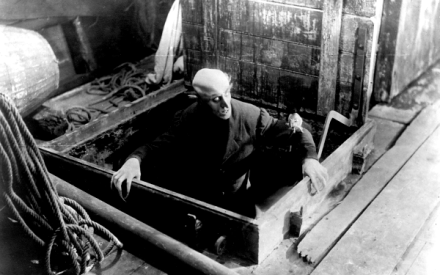


While this is happening "Thomas Hutter" is attempting to make his way back to Wiesborg to warn the citizens and save his wife. "Ellen" is now almost completely under the control of the yet to arrive Count. The ship arrives and hundreds of rats swarm from the streets of Wiesborg bringing both a plague and "Count Orlok". Who while the citizens run in panic do not see the Count carrying his one remaining coffin to the house he purchased.
At the same moment "Thomas Hutter" arrives home and embraces his wife. Now the deaths of the people of Wiesborg begin from the plague brought by the rats and their host "Count Orlok".
In the prison is the real estate agent "Knock" now insane. In actuality he has always been a minion of the Count and the sale of the property was planned together to bring the Count to a new larger source of blood.

"Knock" escapes by killing a guard and finds himself being chased through the streets of Wiesborg and killed. "Professor Bulwer"now becomes involved by figuring out that there is a vampire at large, but his role in this film isn't that important.
"Ellen" starts complaining to "Thomas" about being sick. He leaves to get the town physician "Dr, Sievers". "Ellen" now finds "The Book of Vampires" and reads that:
A VAMPIRE CAN BE DESTROYED, IF A PURE-HEARTED WOMAN DISTRACTS THE VAMPIRE WITH HER BEAUTY."Ellen"? knows why she has been sick. She opens the window to her room to make it easy for "Count Orlok" to enter. Which he does and she distracts him until the rooster crows and the sun destroys the vampire.
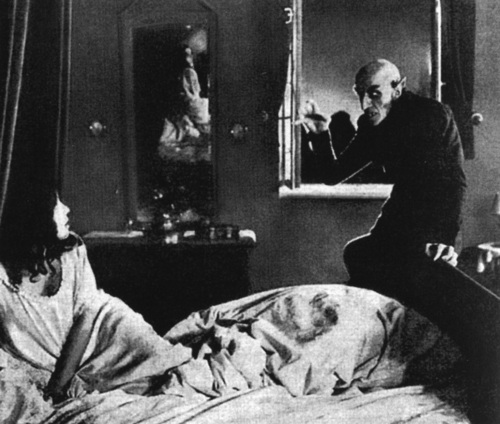
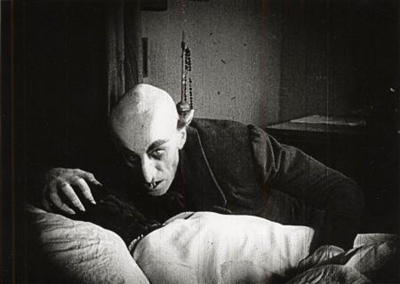
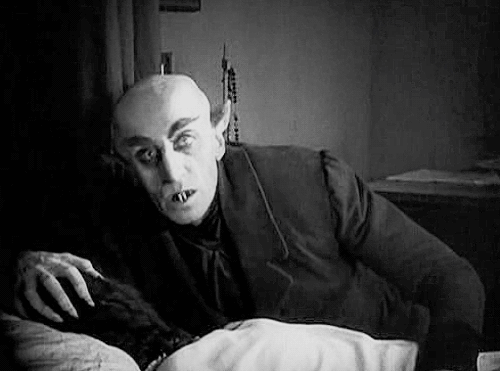

"Hutter" and "Dr. Sievers" enter to see the vampire destroyed by the sunlight. "Thomas" embraces "Ellen" as she dies in his arms. The plague has been beaten and the town saved. The film then shows the Count's ruined castle once more.
It took seven years until June 3, 1929, before American's saw F,W, Murnau's feature film.
It would be another 50 years before the motion picture was remade in Germany by a great director and a great actor.
NOSFERATU: PHANTOM DER NACHT (NOSFERATU: THE PHANTOM OF THE NIGHT) shown first at a sneak preview at the "Cinematheque Francaise) January 17, 1979

The name of the German town is changed and the title character is now not "Count Orlok", but "Count Dracula". There are two versions of the film. One in which the actors speak German and the other with the same cast speaking English. There is no dubbed version as some viewers thought and the two filmed versions are exactly the same. Each scene being shot twice.
The motion picture was filmed by German director Werner Herzog. Herzog was a writer, director and actor. As a director two of his more known German films outside of Europe are 1972's "Aguirre, the Wrath of God" and 1982's "Fitzcarraldo". Both starring Klaus Kinski. As an actor my reader, in the United States, may have seen Werner Herzog as "The Zec" in 2012's "Jack Reacher" and as "The Client" in Chapters 1, 3, and 7 of "The Mandalorian". Herzog directed 71 films through 2019, acted 32 times through 2019, and wrote 58 screenplays through 2019.
This screenplay was also written by Werner Herzog. Who had no problem, now, with using Bram Stoker's novel with characters names changed somewhat, but also used elements of Henrik Galeen's original screenplay.
The Cast
Klaus Kinski portrayed "Dracula". Over his career the Polish actor appeared 137 times through 1990. Besides this picture and the two already mentioned. Are director Jesus Franco's Spanish film "Count Dracula" with Kinski as "Renfield" and Christopher Lee as "Dracula". However, most fans of Clint Eastwood's "Spaghetti Westerns" know the actor as "The Hunchback" in 1965's "For A Few Dollars More".

My article on the career of this great character actor can be read at:
http://www.bewaretheblog.com/2017/12/klaus-kinski-krimis-cowboys-vampires.html
Isabelle Adjani portrayed "Lucy Harker". The French actress was known in the United States for the 1975 French film "The Story of Adele H" prior to this picture. Afterward, she was seen in another French movie 1979's "The Bronte Sisters" as "Emily Bronte".and the 1987 Box Office failure for director Elaine May and actors Warren Beatty and Dustin Hoffman "Ishtar".

Bruno Ganz portrayed "Jonathan Harker". Swiss Actor Ganz had 124 roles by 2019 and among his English language movies are the Gregory Peck, Laurence Oliver and James Mason feature from 1978 "The Boys From Brazil", the Denzel Washington 2004 remake of "The Manchurian Candidate"and Jeremy Iron's 2013 "Night Train to Lisbon". The actor did a very powerful "Adolf Hitler" in the 2004 German film "Downfall".

Roland Topor was "Renfield". French actor and illustrator Topor only has 17 acting roles. As acting was a minor source of income. However, as a writer and illustrator he wrote the animated French Science Fiction film, 1973's "Fantastic Planet", a must see for fans of animation.

Walter Ladengast portrayed "Dr. Van Helsing". This was Austrian actor Ladengast's last motion picture. His career started in 1928 and would end with 110 motion picture and German television productions.
Below Ladengast and Isabelle Adjani.

An Overview of Werner Herzog's Screenplay
My reader should know that Herzog considered F.W. Murnau's original the greatest motion picture to ever come out of Germany. He wanted to remake it specially with Klaus Kinski in the title role. The screenplay and the film is a homage to Murnau rather than a real adaptation of Stoker.
In the German town of Wismar, Germany, an actual location this time on the Baltic Coast of Germany, "Jonathan Harker" works for real estate agent "Renfield". "Renfield" assigns "Harker" to travel to Transylvania to complete the sale of a local property to a nobleman named "Dracula". The happily married "Jonathan" informs his wife "Lucy" of the luck of getting this assignment and what it will bring to them in his commission. He also informs her that he will be gone approximately four weeks. Important dialogue as it sets up a time frame in which no one, including "Lucy", would start to worry about "Jonathan's" return.

"Harker" starts his journey and comes to a village inn. There, after mentioning that he is going to "Castle Dracula". The locals tell him stories of the Count's vampirism and warn him to stay away from the castle and return to Wismar. He considers their tales nothing but local superstition, but takes a book on vampires, they give him to read, and goes to his room for the night. When nobody will take him to his destination the next morning. For some reason "Jonathan Harker" puts the unread book in his things and sets out on foot for the Borgo Pass. There he makes his way up it to "Castle Dracula" and is greeted by the Count.

I should note that this is a "Dracula" who is tormented by the fact he can never grow old and die like normal people. This is neither Bela Lugosi's, Christopher Lee's, or even Gary Oldman's "Dracula".
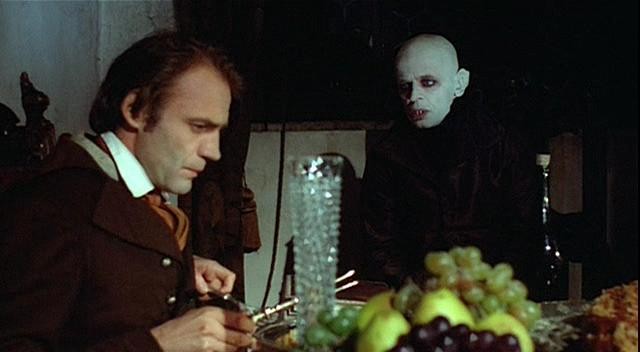
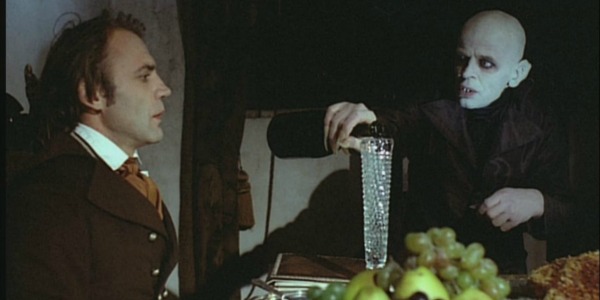
The Count is attracted to a photo of "Lucy" and immediately tells "Jonathan" he will sign the papers for the property in Wismar, because of having a lovely neighbor like his wife. As "Jonathan's" visit continues he starts having vivid dreams of weird encounters with his host. While "Lucy" is having nightmares also about "Dracula", her husband and impending doom.

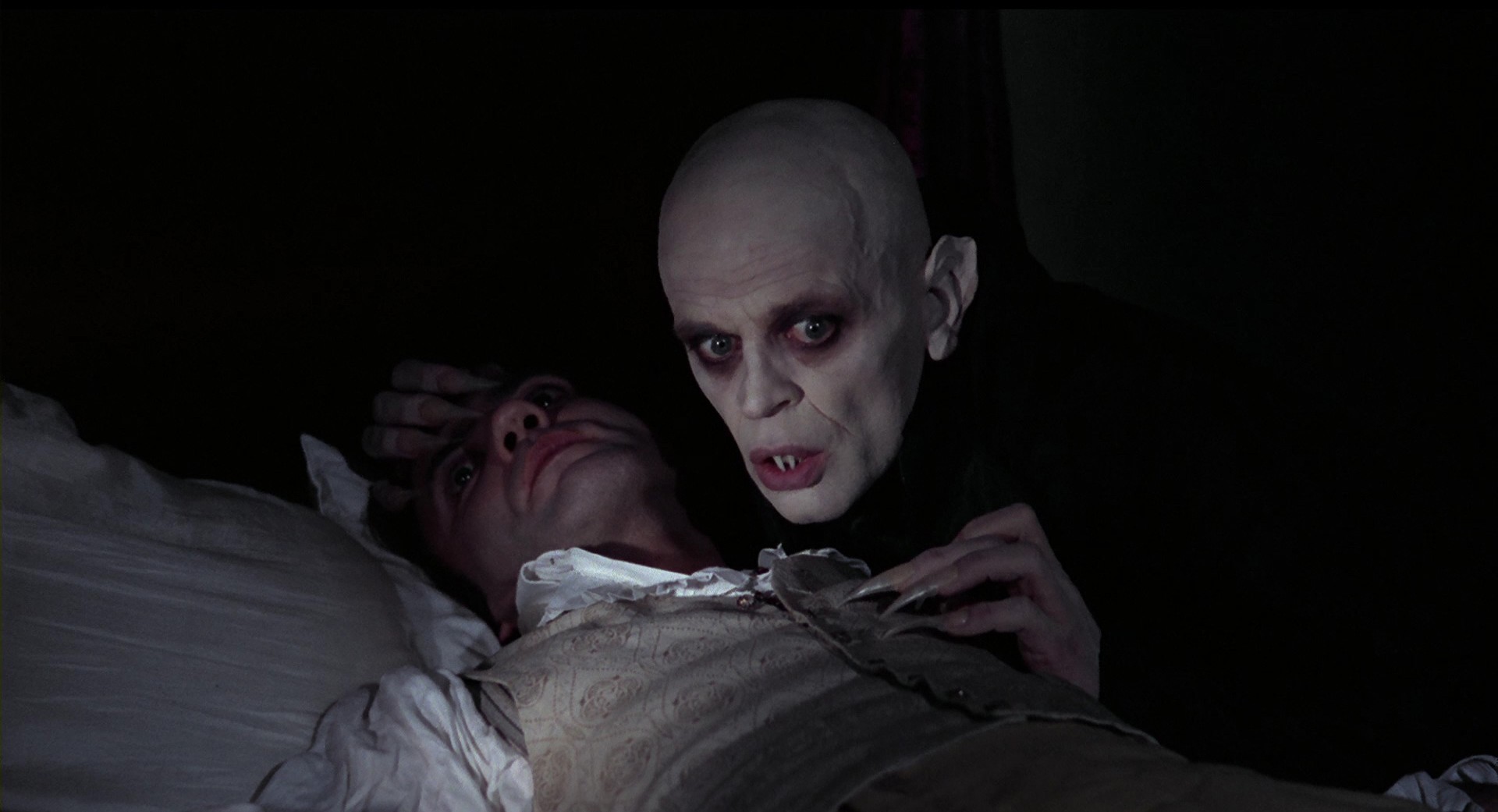
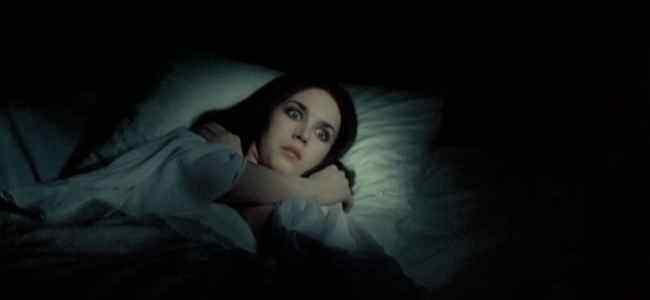
Also in Wismar, "Renfield" is committed to an asylum for biting a cow and attempting to drink its blood.
Back at the Castle, "Harker" now finds "Count Dracula" sleeping in his coffin and the dawning realization of what the villagers at the end had said was true. It also explains his own nightmares and weakness.

"Jonathan" now finds himself imprisoned in the castle. That night he sees "Dracula" loading coffins filed with his native soil and leaving the Castle grounds.

The following morning "Jonathan" finds a rope and breaking open a window uses it to go down the castle's wall. However, the rope is too short and he injures himself by falling. He hears a young gypsy boy playing a violin approaching him----

---and he is taken to a hospital. There he raves about:
BLACK COFFINSHowever, the doctors treating him only think its his mind reacting to the injury.
Meanwhile, "Count Dracula" is on his way to Wismar, over the Black Sea, on a sailing ship. On board the ship he is killing off the crew members by drinking their blood. To anyone finding the crew they would think there had been a plague on board.

The now ghost ship arrives and hundreds of rats run off it. Among those investigating is "Van Helsing". The investigators find a log which tells of the deaths on board. Unseen, the Count now takes a coffin and moves into his new home. As rats spreading the plague run free in Wismar and the deaths begin.



The desperately ill "Jonathan" is transported back to Wismar, but he seems not to recognize "Lucy".

"Lucy" now encounters "Dracula" who asks her for just some of the love she shows "Jonathan", but she refuses him and the Count leaves.

Knowing now that it isn't the rats, but "Dracula" that has caused the plague and "Jonathan's" illness. "Lucy" attempts to convince the townspeople, but they do not believe her. She next finds the book her husband received from the villagers of Transylvania and starts to read it.
"Lucy" discovers that she can destroy the evil that has come to Wismar by keeping "Dracula" in her room until dawn. When the sun will destroy him. She lures the count to her room and surrenders herself to his lust.


At the first crow of the roaster "Count Dracula" collapses to the floor of "Lucy's" bedroom dead.

"Van Helsing" now arrives to find "Lucy" dead, but victorious over the evil that was "Dracula". To be sure that the Count is destroyed he drives a stake through "Dracula's" heart.
TWIST TIME:
"Jonathan" now awakens from his illness and sees what has occurred. He has "Van Helsing" arrested for the murder of "Dracula" and then states he has much to do now. He is seen riding away from Wismar garbed in the same clothing as "Dracula", because "Jonathan Harker" is the new vampire Count.
Either tale of "Nosferatu" was a variation of Bram Stoker's "Dracula", but some film makers were more original with their takes and did not follow Stoker. For those of my readers interested in;
" Not the Same Old Vampire Movies" may article on some of the others I enjoyed can be read at:
http://www.bewaretheblog.com/2017/10/not-same-old-vampire-movies-or-get-your.html
From somnambulists and vampires I move to a serial killer of children.
" M - Eine Stadt Sucht Einen Morder (M- A City Searches for a Murders) released May 11, 1931 in Berlin, the Weimar Republic of Germany
+poster+2.jpg)
This is the classic German motion picture from director Fritz Lang with Peter Lorre.
The film was produced by Seymour Nebenzal. Who also being Jewish and would leave Germany as the Nazi's came to complete power.
Nebenzal produced films from 1927 through 1951 in Germany and the United States. Besides "M", in 1931, Seymour Nebenzal produced the musical "The 3 Penny Opera" with actress Lotte Lenya. She played "Jenny Diva" and because of that role. Lotte Lenya would be immortalized in singer Bobby Darin's 1959 version of the original Kurt Weill song "Mac the Knife" from that film's score .
Now Jenny Diver, ho, ho, yeah, Sukey Tawdry
Ooh, Miss Lotte Lenya and old Lucy BrownHowever, any of my readers familiar with the second "James Bond" film 1963's "From Russia with Love". Know the Tony Winner and Academy Award nominated singer as "Spectre's Rosa Klebb".
Nebenzal was also into Science Fiction Adventure stories such as 1932's "Queen of Atlantis". That he would remake in 1949 as "Siren of Atlantis" with Maria Montez and Jean-Pierre Aumont. In 1943 Seymour Nebenzal made the low budget "Hitler's Madman" starring John Carradine based upon real events.
As I mentioned "M" was directed by Fritz Lang. Who also fled Nazi Germany, because of his religion. "M" was Lang's first sound film. Prior to this feature Lang took a screenplay by, his then wife, Thea von Harbou and the two made 1929's "Women in the Moon". That tale is about a group people who take a rocket ship to the moon in search of gold. The film is more memorable for what Thea von Harbou created to build up tension in a silent motion picture for their audience. When the space craft is ready for take off. The audience sees the numbers of seconds left toward the launch time, become smaller numbers until they reach zero. In short Thea von Harbou created the "Countdown" first used by German rocket scientists.
My look at the film work of Fritz Lang and Hitler's favorite director and cinematographer Leni Rieffensthal can be found at:
http://www.bewaretheblog.com/2015/03/fritz-lang-and-leni-riefensthal-their.html
The screenplay for "M" was also by Fritz Lang and Thea von Harbou. Although probably their most famous collaboration was director Lang's Science Fiction classic 1927's "Metropolis". The screenplay for "M" was based upon a newspaper article from Egon Jacobson about serial killer Peter Kurten.

Above is Kurten's 1931 mug shot.
Peter Kurten was known as either the "Vampire of Dusseldorf", or the "Dusseldorf Monster", because he attempted to drink the blood of some of his victims. Kurten committed a series of sexual assaults and murders between February and November 1929. Once arrested he confessed to the 1913 murders of both a 9 year old girl and a 17 year old girl. He was known to have committed other sexual murders going back to 1899. On, May 23, 1931, 12 days after the release of "M", Kurten confessed to his wife about the murders and she turned him in. On July 2, 1931 he was executed by beheading.
The Two Main Roles
Peter Lorre portrayed "Hans Beckert" in only his third film. For his first two Lorre received no on screen credit, but here he had first billing as the serial child murderer. Three years later, Jewish actor Peter Lorre, he had fled Nazi Germany for the U.K., would have third billing in his first English language motion picture. The feature was director Alfred Hitchcock's 1934 original "The Man Who Knew Too Much".
My article "Peter Lorre: Overlooked, or Forgotten Performances" is found at:
http://www.bewaretheblog.com/2017/11/peter-lorre-overlooked-or-forgotten.html

Otto Wernicke portrayed "Inspector Karl Lohman". The actor returned to the same role in Fritz Lang's 1933 "The Testament of Dr. Mabuse". In 1943 Nazi Germany turned the sinking of the White Star Liner "Titantic", the name of the film, into the story of a heroic German Officer on the sinking ship. Wernicke portrayed the liner's "Captain Edward J. Smith". His last role was on German television in 1962.

An Overview of the Screenplay
The film is a character study and there are no real major roles except that of Peter Lorre,
The film starts out with a series of images forming the establishing sequence. Children are playing an elimination game and singing about a murderer of children. One has to think of the similar song in Wes Craven's 1984 "Nightmare On Elm Street" with a similar set up.

A woman is sitting a table waiting for her daughter to come home for her meal after school. A wanted poster warns of a serial killer of children. Other parents are awaiting at the school to walk their children home.
"Elsie Beckmanm" played by Inge Lundgut, is on her way home from school bouncing a ball. When she is approached by "Hans Beckert". He offers to buy her a balloon from a blind beggar, played by George John.
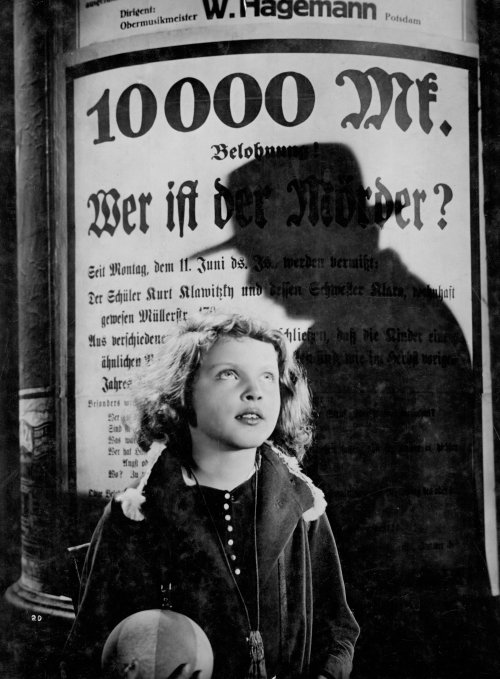
The blind beggar recognizes the tune "Beckert" is whistling. It is composer Edward Grieg's "In the Hall of the Mountain King" and will become important later. "Hans" and "Elsie" are next seen walking together. Cut to her place at the table remaining empty, the ball is seen rolling across a lawn and the balloon is caught in some wires. End of opening sequence.
With the disappearance of "Elsie" Berlin parents are worried about their children. To make matters worse an anonymous letter, from "Hans Beckert", is received by the police promising more children will be murdered. The police now use, what was then two new concepts, fingerprinting and handwriting analysis to be able to identify the killer once he's found. "Inspector Karl Lohmann" is assigned the case and instructs his men to intensify their searches and questioning, check on any recent psychiatric releases of children molesters, and start raids against known criminals and their associates. In short the city is in panic.

The police raids are causing concern among the "Underworld" and "Der Schranker (The Safecracker)", played by Gustaf Grundgens, calls a meeting of the cities crime lords to form their own hunt for the killer.

As "Der Schranker", above, has his own child. The beggars are instructed to watch all children who are alone and protect them.

The police have suspicions that "Hans Beckert" may be the killer and search his rented room for clues. They find evidence connecting "Beckert" and wait, hidden, for his return.

"Beckert" is now following a young girl he saw reflected in a shop window, but stops when her mother appears. Another little girl surprises him with a knife at a toy store.


Eventually, he finds another girl and befriends her and as the two are walking "Beckert" is whistling.

The blind beggar hears the whistling as the two pass him. He contacts another beggar who starts to follow the two and beggars along the way start to watch.

At one point another man seems to accidentally bump "Hans Beckert", but puts a chalk marked "M for Murderer" on the back of his coat. "Beckert" leaves the girl as he realizes he's being followed, but has no idea the letter is on his overcoat to identify him to others.
"Hans Beckert" now sees a large office building with the workers exiting for the night and enters it.


His plan is to hide there, but he has been spotted and the word goes out to "Der Schranker". He arrives with a group of criminals and is met by a night watchman. The watchman won't reveal what he knows about "M" and is tortured. Then two others are discovered and it is finally found out that "Hans Beckert" is in the attic. There they capture the child killer, but one of the watchmen triggered a silent alarm and the criminals with their captive barely get away before the arrival of the police.

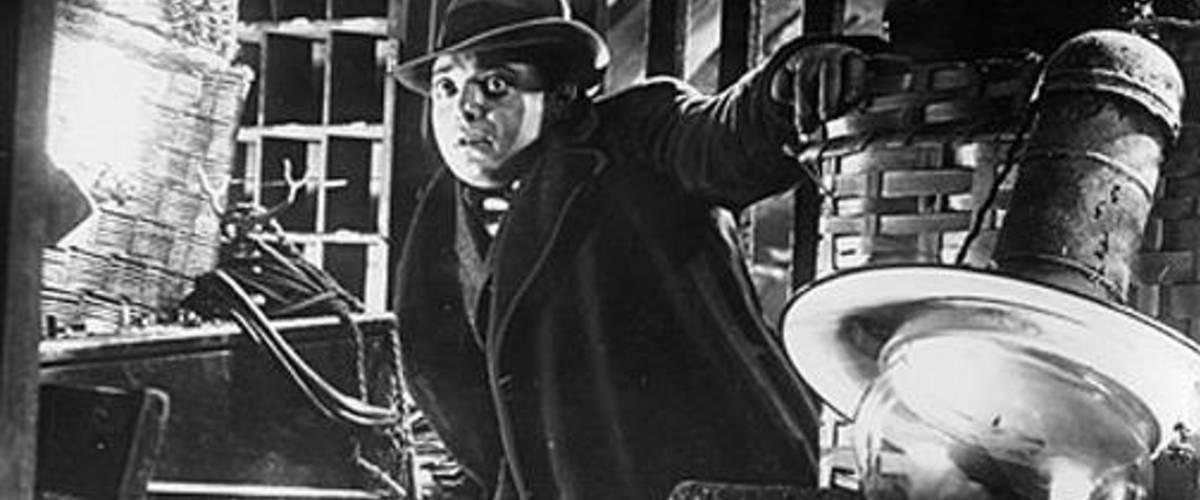
However, left behind in the confusion of the police arriving. The criminal named "Franz", played by Friedrich Gnab, is captured and taken to "Inspector Lohman".

"Franz" is tricked into revealing that the criminals have "Hans Beckert" and where they've got him.
Meanwhile, the criminals take "Beckert" to an abandon distillery to face their "Kangaroo Court".


To be fair "Hans Beckert" is given a Defense Attorney, or sorts, as their is a Prosecuting Attorney also appointed by "Der Schranker".
It is the blind beggar that identifies him to the court.
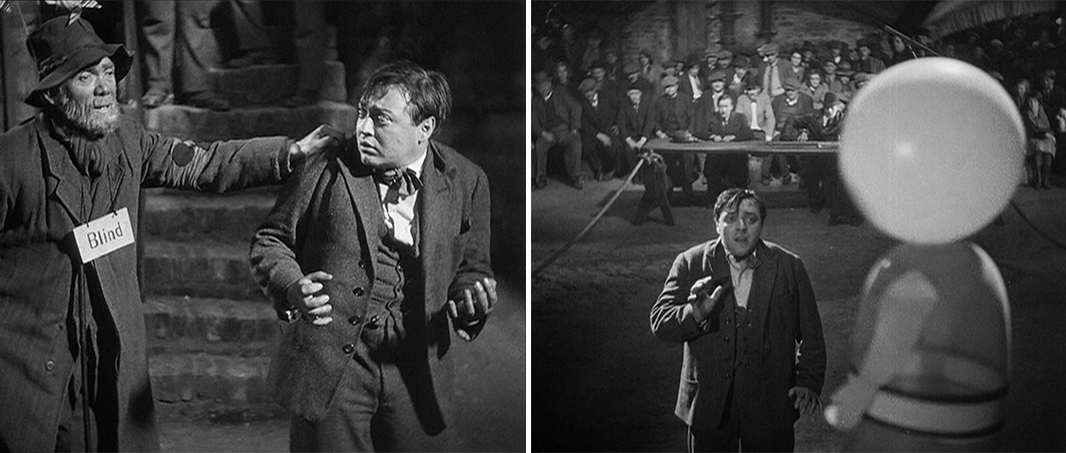
"Beckert" now gives an impassioned monologue about how he can't control his homicidal urges.
Then he asks how criminals can really pass judgement upon him adding:
What right have you to speak? Criminals! Perhaps you are even proud of yourselves! Proud of being able to crack into safes, or climb into buildings or cheat at cards. All of which, it seems to me, you could just as easily give up, if you had learned something useful, or if you had jobs, or if you were not such lazy pigs. I can not help myself! I have no control over this evil thing that is inside me – the fire, the voices, the torment!

"Hans Beckart's" appointed attorney asks the court how they can kill an insane man?
Just as the criminals are about to kill "Beckert" the police arrive and arrest him and the others.
Cut to "Hans Beckert's" real trial as judgement is about to be passed. The mothers of three of the his victims are seen to be crying and the mother of "Elsie" says:
No sentence will bring the dead children back, One has to keep closer watch over the children.The screen starts to fade to black as she adds:
ALL OF YOU!It would take 20 years before anyone attempted a remake of Fritz Lang's classic and that person was the original producer Seymour Nebenzal and his son Harold. However, the motion picture was considered lost for decades and a print discovered and restored by Seymour Nebenzal in 2015.
M released in March 1951
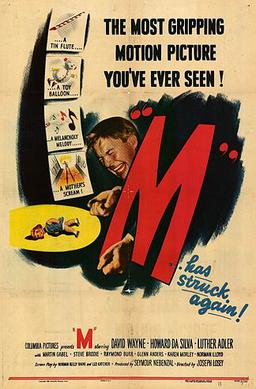
This film would become a target of the FBI and the "House Committee On Un-American Activities" upon its release.
Seymour Nebenzal retained the rights to the 1931 Fritz Lang version when he left Nazi Germany. So there was no problem in that area to remaking the motion picture. Nebenzal first approached Lang to direct the proposed feature, but he turned Seymour down, He could not believe that the other wanted to remake the one film Fritz Lang considered his "masterpiece".
Next Seymour Nebenzal approached director Douglas Silk.. Who also was part of the Jewish emigre community from Nazi Germany. He refused, because he was also a friend of Lang. Silk would go on to make Rock Hudson a major star with films for Universal Pictures. That included 1954's "Taza, Son of Cochise", 1954's remake of "Magnificent Obsession", 1955's "Captain Lightfoot", 1955's "All That Heaven Allows", and and 1956's "Written On the Wind".
Nebenzal next turned to director Joseph Losey. Losey had filmed the Dean Stockwell, Robert Ryan and Pat O'Brien parable depicting the problems facing War World 2's orphan children, 1948's "The Boy With the Green Hair". Losey agreed to direct "M", but he was under suspicion of being a "Communist" by the FBI and the "House Committee on Un-American Activity". Losey would be "Blacklisted" and go to the U.K. where, without on screen credit, he directed the excellent Hammer film 1956's "X-the Unknown" and with full credit the excellent and overlooked Science Fiction 1962's "Children of the Damned". He also directed the excellent "James Bond" spoof, based upon a British comic book series, 1966's "Modesty Blaise".
The casting by Joseph Losey would include some actors under investigation by the FBI and the "House Committee on Un-American Activity". His assistant director was Robert Aldrich in his 25th assistant director position. Aldrich would go on to direct, among other films, 1962's "Whatever Happened to Baby Jane", 1965's original "The Flight of the Phoenix" and 1967's "The Dirty Dozen".
The screenplay was written without on screen credit going to Fritz Lang and Thea von Harbou.
The screenplay was primarily written by Oscar winning, 1937 "The Life of Emile Zola", writer Norman Reilly Raine. Who also wrote the Errol Flynn 1939 "The Adventures of Robin Hood" and the same years "The Private Lives of Elizabeth and Essex" with Flynn and Bette Davis.
Raine's first co-writer was Leo Katcher Katcher only wrote 9 screenplays, but they included 1957's "The Eddie Duchin Story" starring Tyrone Power and the excellent gangster film 1958's "Party Girl" starring Robert Taylor.
The second co-writer was Waldo Salt. Salt would write the screenplays for 1962's "Taras Bulba", 1969's "Midnight Cowboy", 1973's "Serpico" and 1978's "Coming Home".
The Main Cast
David Wayne was "Martin W. Harrow" the serial child murderer. Wayne usually was known as a supporting actor. He played the singer/song writer neighbor of Spencer Tracy and Katherine Hepburn in 1948's "Adam's Rib". Wayne appeared with Marilyn Monroe in 1951's "As Young As You Feel", 1952's "We're Not Married" and 1953's "How to Marry a Millionaire". In 1955 he co-starred with Frank Sinatra and Debbie Reynolds in "The Tender Trap". So the idea of David Wayne portraying a child murderer was way off character. Although he did dramatic roles such as 1957's "The Three Faces of Eve" and 1971's "The Andromeda Strain".

Howard Da Silva was "Inspector Carney". Da Silva was one of Losey's actors under suspicion of being a "Communist Sympathizer" by the FBI and the "House Committee on Un-American Activity". He would be "Blacklisted" and not appear in feature films until 1961. However, he had no problem with getting roles on the legitimate stage in New York on Broadway. His films included 1931's "The Sea Wolf" starring Edward G. Robinson, director Billy Wilder's classic 1945 "The Lost Weekend" starring Ray Milland, the 1946 Alan Ladd and Veronica Lake "The Blue Dahlia", 1949's "The Great Gatsby" also starring Ladd and in 1972 Da Silva repeated his Broadway role in the musical "1776" as "Dr. Benjamin Franklin". Da Silva is center below.

Martin Gabel was "Charlie Marshall" the crime boss. Gabel was part of Orson Welles original "Mercury Theatre of the Air". "M" was the stage and radio actors second on screen appearance. His next film was Humphrey Bogart's 1942 "Deadline U.S.A.". After this film, besides stage work, Martin Gabel mainly appeared in a variety of television genre's, but also directed motion pictures.

Luther Adler portrayed "Daniel Langley" the Gangster Defense Attorney. Adler started out in the Yiddish Theater as part of a dynasty of Adler's on the Jewish stage. He then became a Broadway actor, a movie and television actor and director in all three mediums. His pre-1951 movie career included the 1937 George Sanders "Lancer Spy", the Alan Ladd 1947 "Saigon", John Wayne's 1948 "Wake of the Red Witch" and Edmond O'Brien's 1949 "D.O.A.". Below Luther Adler and David Wayne.

Janine Perreau portrays "The Last Victim". She had been acting since 1947 and would until 1959. However, most 1950's Science Fiction fans know her as Jimmy Hunt's next door neighbor "Kathy Wilson" in 1953's "Invaders from Mars".

Raymond Burr portrays one of the gangsters named "Pottsy". By this time Burr had appeared in films 22 times since 1946, but mostly small overlooked roles. 1951 was the year he started to be noticed and besides "M" he appeared another 12 times between movies and television.

The screenplay follows the original story with slight changes and additions, but moved it from Berlin, Germany, to 1951 Los Angeles, California. The screenplay changed the names of the characters, but anyone familiar with the 1931 motion picture can easily identify them.
When I saw the film recently on television. It had me thinking, because most of the locations, the long forgotten and torn down "Bunker Hill" area, are places I grew up around in the early 1950's and could imagine what Fritz Lang's original Berlin audience felt. Below David Wayne on a bench at the top of "Bunker Hill".

There is one interesting twist to the murderer in this picture. He keeps the shoes of his victims behind a secret panel in his apartment. It is established that "Martin Harrow" is obsessed with shoes and this will turn out to be a critical mistake.

Above David Wayne's "Martin Harrow's" obsession is illustrated to the audience by director Joseph Losey.
The opening is very close to Fritz Lang's original. A little girl playing at the local neighborhood carnival, something very familiar at the time, is approached by the friendly "Martin". He buys a balloon from a blind street vendor, played by John Miljan, and walks away with the girl playing a tune on a flute. Think the "Pied Piper of Hamlin".

The city goes into a panic and in the following stills a man seems to be kidnapping a girl in front of a movie theater and others react. Of course it's all a mistake as he's her father, but a great way to illustrate the fear going through Los Angles. Also note that wherever this was shot the 1948 classic ballet film "The Red Shoes" was showing.

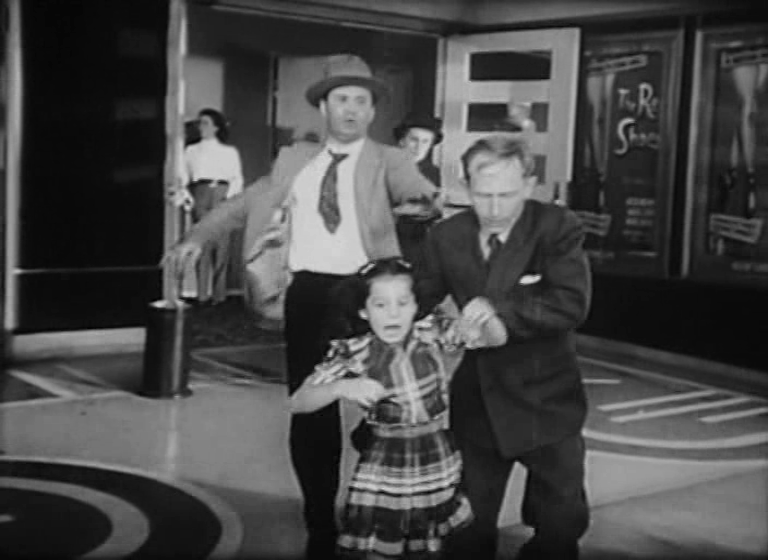
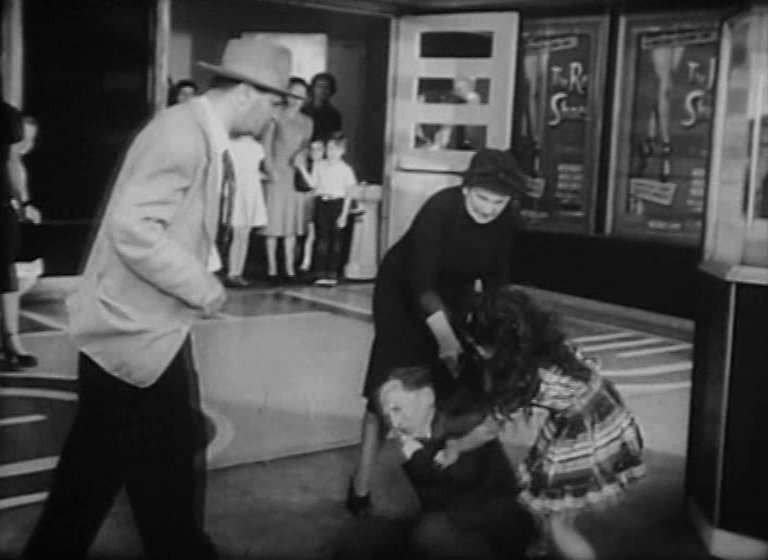
While the police, at the direction of "Inspector Carney", start a manhunt for the killer. The criminal element is being taken in for questioning causing "Charlie Marshall" to call a meeting and start the underworld's own hunt for "M for Murderer". As in the original 1931 film.
Meanwhile, "Martin Harrow" finds his next victim.

Another change to the story is about Luther Adler's character of "Daniel Langley". He is a real lawyer. but an alcoholic. He's pulled into a local police station during the crack down ordered by "Inspector Carney", because he's known to work for "Marshall's" crime syndicate.

At the police station a psychologist runs a profile of the child murderer. As a result the police start investigating single men who are known to have, or have had mental illnesses. This leads to an apartment house and "Martin Harrow's" apartment. To gain entrance the police tell the landlord they're from the Health Department. The police search the place, he is away, and find nothing but a shoe lace tied to a lamp. Returning to the station they mention the shoe lace in passing.
One thing "Martin Harrow" is doing different than "Hans Beckert" is keeping the shoes of his victims. Hearing about the shoe lace "Inspector Carney" orders a return to "Harrow's" apartment.
Meanwhile, "Martin" and the little girl are walking through the city and come across the blind street vendor. "Harrow" buys her a balloon and starts playing his tune on the pipe. This alerts the vendor who contacts another man and both are now being followed by the criminal underworld. One man is able to get close enough to place the letter "M" on the back of "Harrow's" jacket with a piece of coal.
The police arrive back at the apartment house and start their second search of "Martin Harrow's" apartment. In the closest they find a secret panel and opening it the shoes of all his victims.


Below Steve Brodie as "Lieutenant Becker" and Howard Da Silva as "Inspector Carney" looking at the shoe lace that was on the lamp.

As "Martin" and the little girl are walking into a store. She notices and mentions the letter "M" on his coat. "Martin Harrow" now goes into panic mode knowing somebody is after him and still taking the girl heads out to find a hiding place.

The enter "The Bradbury Building" on the corner of West 3rd Street and South Broadway.
Below is a photo of the exterior in 2005. The building was built in 1893 and became an Historical Landmark in 1977. This motion picture captures the inside of the building back in 1951.

The night watchman accidentally locks the two inside a mannequin storage room. Outside members of "Marshall's" groups have followed the two and now inform their leader. While "Inspector Carney" and the police are forging ahead with their own manhunt.
Inside "Harrow" is attempting to break out of the locked room.

"Charlie Marshall" arrives and a search of the inside of the building begins. During the search an alarm is set off alerting the police.


"Marshall's" men hear the pounding on the door as "Harrow" is attempting to get out. They break it open, free the little girl, and capture "Martin".

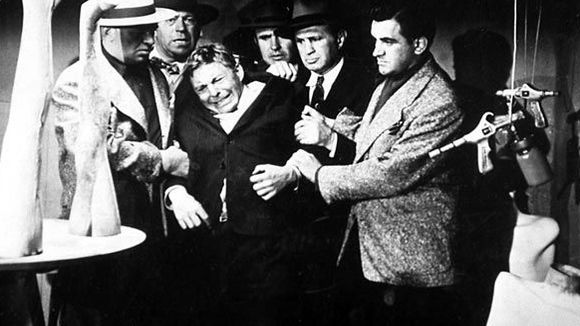
The trial of "M" now takes place and includes the exact English translation of Peter Lorre's pleas.

Below lawyer "Dan Langley" pleads "Martin Harrow's" case.

"Dan Langley" starts verbally attacking "Charlie Marshall" over his criminal background as part of his defense of "Martin Harrow" and "Marshall" shoots him dead. Just as "Harrow" is about to be killed for his crimes. The police arrive and arrest everyone and get their serial child murderer.

An anonymous reviewer in "Variety" did a review of the film upon its release. The review stated:
David Wayne, as the killer of small children, is effective and convincing. Luther Adler, as a drunken lawyer member of a gangster mob, turns in an outstanding performance, as do Martin Gabel, the gang-leader, and Howard da Silva and Steve Brodie as police officials ... Joseph Losey’s direction has captured the gruesome theme skillfullyMy reader might ask why anyone writing for the "Hollywood Trade Paper Variety" wouldn't want their name associated with their review. The answer is simple. This was 1951 America and Senator Joseph McCarthy and his "Communist Witch Hunts" held sway. Even the studios were co-operating with the "House Committee on Un-American Activities". As was the "Screen Actors Guild (SAG)" under current President actor Ronald Reagan. Some actors, producers and directors were turning in their friends to save their own hides from "Blacklisting".
I already mentioned what happened to director Joseph Losey and Luther Adler. There were others in the cast and crew that met their demise during this period.
Because of director Joseph Losey's known political views the motion picture was boycotted in many United States cities. In fact the State of Ohio refused to show 1951's "M" anywhere in the State. However, their refusal went up to the United States Supreme Court in 1953. The court ruled against Ohio. The movie opened without the slightest editing later in 1953.
Remakes, or reinterpretations of an original film can work both ways. Sometimes, one can ask why they did it in the first place? A classic example, in my opinion, is the remake of Alfred Hitchcock's 1960 "Psycho" in 1998. They took Joseph Stefano's original screenplay, changed the actors in the roles, but kept the names and the story as written, and re-shot "Psycho" in color. The 1960 original budget was $807,947 dollars. The 1998 budget was $60 million dollars. The 1960 motion picture's box office was $50 million dollars. The 1998 box office was $37.1 million dollars.


No comments:
Post a Comment